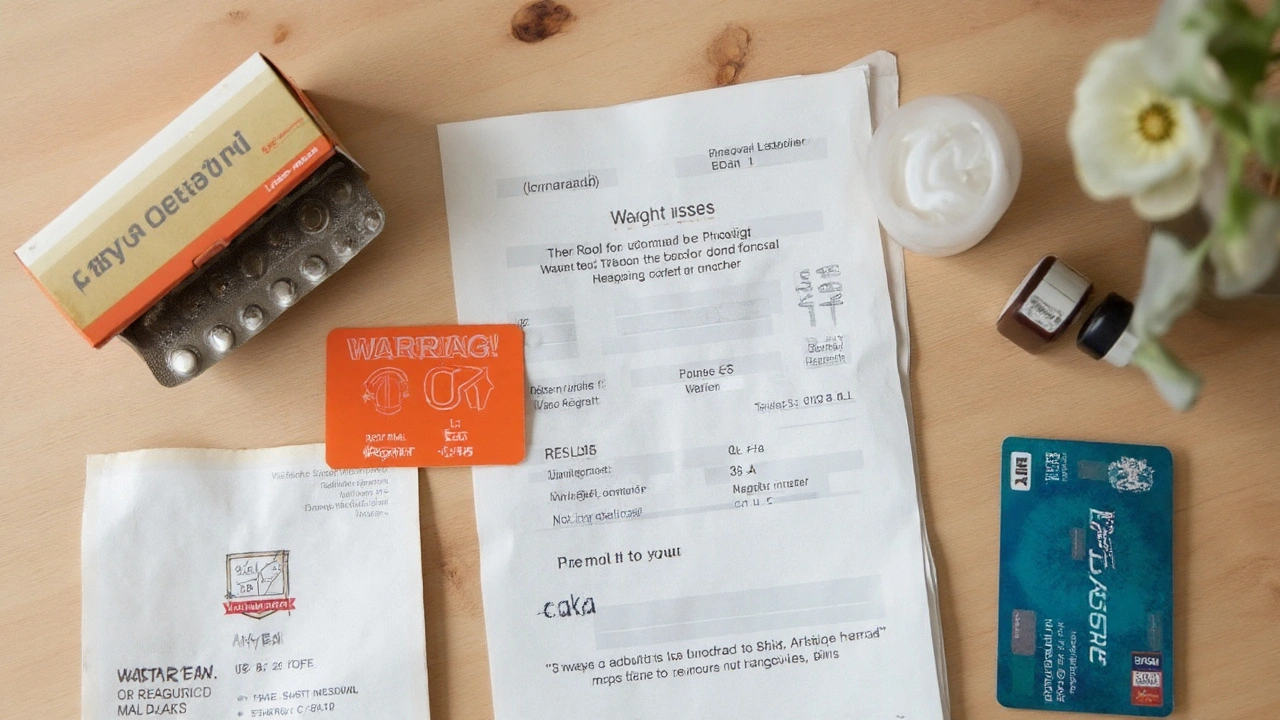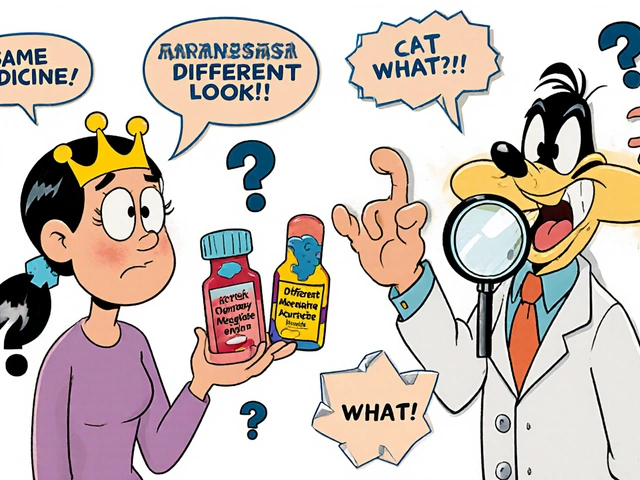Hunting for cheap generic Tylenol online? You’re in the UK, so the name you actually want is paracetamol. The goal is simple: pay a fair price, avoid sketchy sellers, and get the right strength delivered fast without risking your health. I’ll keep it practical - what to buy, what it should cost in 2025, how to check a pharmacy’s legitimacy, the rules on pack sizes, and the safety basics that matter.
If you’ve ever stared at a page full of “lowest price” claims and felt uneasy, this will help you sort the real deals from the risky ones. And yes, you can buy generic Tylenol online cheaply in the UK - you just need to know what counts as legit, what’s a normal price, and when to walk away.
What you’re actually buying: generic Tylenol = paracetamol 500 mg
“Tylenol” is the US brand name for acetaminophen. In the UK, the same active ingredient is called paracetamol. When you see “generic Tylenol,” think “paracetamol 500 mg tablets or caplets.” That’s the standard adult strength for pain and fever.
Key points so you don’t get tripped up by labels:
- Active ingredient: paracetamol (aka acetaminophen). Same molecule, different name.
- Common adult strength: 500 mg per tablet.
- Formats: tablets, caplets, soluble/effervescent tablets, capsules, and liquid (for those who can’t swallow tablets).
- Brand vs generic: under MHRA rules, a licensed generic must match the brand in active ingredient, strength, quality, and clinical effect.
- Combo products: cold/flu sachets, “multi-symptom” tabs, and many over-the-counter painkillers already contain paracetamol. Easy to double-dose by mistake, so read the label.
In shops, you’ll also see pharmacy “P” packs and general sale “GSL” packs. GSL packs (often 16 tablets) can be sold in supermarkets and convenience stores. Pharmacies can supply bigger packs (commonly 32 tablets). Online, legitimate UK pharmacies follow the same rules.
Prices, pack sizes, and what’s “cheap” in the UK (2025)
Paracetamol is one of the most affordable medicines in Britain, which is why wild price claims online should raise an eyebrow. Here’s what “cheap but legit” looks like right now.
- Typical 16-pack (500 mg): around £0.39-£0.89 in supermarkets; £0.59-£1.49 at high-street or online pharmacies.
- Typical 32-pack (pharmacy supply): usually £0.89-£2.49 depending on brand and format (soluble and caplets often cost more).
- Shipping: often £1.99-£3.99 unless you hit a free-shipping threshold (£20-£35 is common). Click-and-collect can be free or £1-£2.
Per-tablet math helps:
- £0.49 for 16 tablets = ~3.1p per tablet.
- £1.49 for 32 tablets = ~4.7p per tablet.
- Beware “1p tablet” claims from unknown sites - that’s often bait.
Soluble tablets cost more (and contain sodium). Liquids cost more per dose. If a price is ultra-low and the site looks off, assume it’s not worth the risk.
| Seller type | Common pack size | Typical price (2025) | Typical shipping | Approx. per tablet | Notes |
|---|---|---|---|---|---|
| Supermarket (in-store) | 16 x 500 mg | £0.39-£0.89 | None (in person) | 2.4p-5.6p | Often limited to 2 packs per sale. |
| High-street pharmacy (in-store) | 16 or 32 x 500 mg | £0.59-£2.49 | None (in person) | 3p-7.8p | 32-packs are common; advice available. |
| Online UK pharmacy | 16 or 32 x 500 mg | £0.69-£2.49 | £1.99-£3.99 (often free over £20-£35) | 3p-7.8p | Check GPhC registration; watch shipping cost. |
| Unknown marketplace seller | Varies | “Too good to be true” prices | Varies | Often unclear | High counterfeit/expiry risk; avoid. |
Why prices differ online: shipping, brand, format (soluble vs plain), and whether a pharmacist review is required for larger packs. Expect to pay a small premium online unless you’re bundling other essentials to hit free delivery.

How to safely order online in the UK (step-by-step + checklist)
If you only remember one thing, make it this: buy from a UK-registered pharmacy. Don’t rely on glossy logos - verify.
- Confirm you’re buying paracetamol 500 mg. On the product page, the active ingredient should be clearly stated as paracetamol (acetaminophen) 500 mg per tablet.
- Check registration. Look up the pharmacy on the General Pharmaceutical Council (GPhC) register. This is the UK regulator. If you’re in Northern Ireland, Community Pharmacy NI and the EU common logo rules may still apply.
- Look for a real UK pharmacy premises. Reputable sites show their registered pharmacy name and GPhC number. Cross-check on the GPhC register.
- Review pack size and legal limits. Retailers in Great Britain follow MHRA guidance on pack sizes and sales limits for paracetamol. You’ll typically see 16- and 32-tablet packs, with restrictions on how many you can buy in one transaction.
- Check the return/refund policy. Medicines usually can’t be returned once dispatched, unless faulty. A clear policy is a good sign.
- Check expiry dates and batch numbers upon delivery. Legit stock carries a clear expiry and batch code. If the packaging looks tampered with, don’t use it.
- Pay securely. Use card payments or trusted wallets. Avoid bank transfers to unknown sellers.
- Delivery timing. Standard delivery is often 2-4 working days. If you need it today, click-and-collect or a local pharmacy run beats waiting.
What not to do:
- Don’t try to bypass quantity limits by splitting orders - sellers track this and the limits exist to prevent misuse.
- Don’t buy from overseas sites to “save pennies” - you risk delays, different pack standards, and counterfeit stock.
- Don’t mix paracetamol products without reading labels - accidental overdose is common.
Quick buyer’s checklist:
- UK-registered pharmacy verified on the GPhC register.
- Product: paracetamol 500 mg, not a combination unless you need it.
- Pack size and per-tablet price clearly shown.
- Shipping cost and delivery timeline make sense for your need.
- Expiry date on arrival is at least 12 months out for tablets (most are 24-36 months from manufacture).
Ready to order? Keep it simple: if you just need short-term pain relief, one 32-tablet pack of 500 mg usually covers a few days for an adult. If pain or fever persists beyond 3 days, get advice from a pharmacist or your GP rather than stacking more orders.
Dosing, safety, and red flags you shouldn’t ignore
Paracetamol is effective and gentle on the stomach compared with NSAIDs, but it’s unforgiving if you exceed the dose. UK guidance is consistent year after year for adults:
- Standard adult dose: 500 mg-1,000 mg (1-2 tablets) every 4-6 hours as needed.
- Do not exceed: 4,000 mg (8 tablets of 500 mg) in 24 hours.
- Space doses: at least 4 hours between doses.
Children’s dosing is weight-based. Use a children’s paracetamol product and follow the label or ask a pharmacist. Don’t guess.
Important cautions (evidence-based from UK/NHS and regulatory guidance):
- Liver disease or regular heavy alcohol use: talk to a pharmacist or doctor before using paracetamol; lower maximums may be advised.
- Warfarin: paracetamol can increase INR if taken regularly for several days; monitor and seek advice if you need it beyond occasional doses.
- Isoniazid and some anti-epileptics: may increase liver risk when combined with paracetamol - check with a pharmacist.
- Pregnancy and breastfeeding: paracetamol is the first-choice painkiller when used at the lowest effective dose for the shortest time; if pain persists, get medical advice.
- Cold/flu remedies: many contain paracetamol already. Don’t double-up.
Overdose is a medical emergency. If you think you, your child, or someone else has taken too much - even if they feel fine - seek urgent medical help immediately. Early treatment matters.
Common mix-ups to avoid:
- Taking 1-2 tablets, then adding a “flu sachet” an hour later (which already contains paracetamol).
- Using soluble tablets without realising they contain sodium - not ideal if you’re watching salt or have heart conditions.
- Assuming “extra strength” means faster relief; it typically just refers to 1,000 mg (2 tablets) rather than 500 mg.
How paracetamol compares to ibuprofen for common problems:
- Headache/tension: paracetamol works well and is gentle on the stomach.
- Period pain/toothache/muscle strain: ibuprofen may work better for inflammation; if you can’t take NSAIDs, paracetamol is the safer default.
- Fever: both reduce temperature; stick with one or the other unless a healthcare professional advises alternating.

FAQs, alternatives, and a simple decision guide
Short, honest answers to the questions people ask right before they buy.
Is Tylenol the same as paracetamol?
Yes. Tylenol is the US brand of acetaminophen. In the UK, it’s called paracetamol. Same active ingredient, same effect when the dose matches.
What’s a fair online price in 2025?
About £0.69-£2.49 for 16-32 tablets, before shipping. Cheaper is possible in supermarkets, but you’ll need to go in person.
How many can I buy online?
UK retailers follow MHRA guidance and local policies limiting pack numbers in one transaction to reduce overdose risk. Expect limits (e.g., two GSL packs, or one/few pharmacy packs). Don’t try to game the system.
Do generics work as well as brands?
Yes. Licensed generics must match the brand for active ingredient, strength, quality, and clinical effect under MHRA rules.
Is soluble paracetamol better?
Not for most people. It works similarly but can be easier if you struggle to swallow tablets. It contains sodium, which some people need to limit.
Can I take paracetamol with ibuprofen?
Many adults can, because they work differently. If alternating or combining, keep a written schedule to avoid overdosing either. If you have ulcers, kidney issues, or asthma, ask a pharmacist before using ibuprofen.
Can I drink alcohol?
Light, occasional alcohol is usually fine within the max daily dose, but regular heavy drinking increases liver risk. If in doubt, avoid alcohol when taking paracetamol.
How long should a pack last me?
If you take two tablets up to four times a day (maximum), a 32-pack covers two days. Most people use less. If you find yourself reordering often, speak to a healthcare professional to address the cause of the pain.
What if delivery is slow and I need it tonight?
Use click-and-collect from a major pharmacy chain or a local pharmacy. Supermarkets also carry 16-packs.
My package arrived with a short expiry date. Is that normal?
Tablets usually have long shelf lives. If the date is within a few months or the packaging looks off, contact the pharmacy for a replacement. Don’t use anything that looks tampered with.
Alternatives if paracetamol isn’t enough:
- Ibuprofen (if you can take NSAIDs) for inflammatory pain.
- Topical NSAIDs (gels) for sprains/strains with fewer systemic effects.
- Non-drug options: rest, ice/heat, hydration, gentle movement for tension headaches and muscle aches.
Quick decision guide:
- Need general pain/fever relief and have a sensitive stomach? Start with paracetamol.
- Pain clearly inflammatory (sprain, dental, period cramps) and you tolerate NSAIDs? Consider ibuprofen; if you can’t use it, stick with paracetamol.
- Pain lasting more than 3 days or keeps returning? Get advice rather than just refilling the basket.
What I personally do (and I live in the UK): I check the GPhC register first, then scan the per-tablet price. If shipping wipes out the saving, I either add a couple of essentials to hit the free-shipping threshold or pop to a local pharmacy. Simple beats chasing a “deal” that isn’t one.
Safe, sensible next step: choose a UK-registered online pharmacy you already trust, buy one 32-pack of paracetamol 500 mg for short-term use, and stick to the dosage. If symptoms don’t improve, talk to a pharmacist or your GP rather than stacking more orders.





Karen Ballard
August 22, 2025 AT 01:18Paracetamol 500 mg is the one to grab if you want the generic Tylenol equivalent - stick to that strength for adults.
Check the GPhC registration before you hit buy, and make sure the product page states paracetamol (acetaminophen) 500 mg clearly.
Watch the per‑tablet math and factor in postage - sometimes the saving vanishes once shipping is added 🧾💸.
On arrival, scan the expiry and batch code; if packaging looks off, don't use it and return it right away.
Gina Lola
August 22, 2025 AT 01:46Also worth noting: supermarkets often sell the cheapest 16‑packs but they limit you at tills, so online "deals" that look cheaper can be misleading when you factor in quantity limits and delivery.
Soluble versions cost more and add sodium load, so if you're salt‑sensitive stick to plain tablets.
And yeah, generics are fine - MHRA licences mean they match the brand on active ingredient and effect, so don’t overcomplicate the choice.
Leah Hawthorne
August 23, 2025 AT 00:00Dosage rules are the real deal: max 4,000 mg in 24 hours for adults, and spacing at least four hours between doses keeps you safe.
People forget that many cold/flu combos already have paracetamol, so doubling up is an easy slip-up.
If you drink heavily or have liver disease, use way less and get pharmacist advice - treatment thresholds change.
For kids, always use weight‑based products and the dosing syringe provided; eyeballing amounts is dangerous.
Finally, if you're reordering a lot, that's a red flag to see a GP rather than treating symptoms with continuous paracetamol.
Brian Mavigliano
August 24, 2025 AT 03:46People treat paracetamol like candy until it bites them - it’s deceptively benign until the liver ends up paying the bill.
Buying cheap online is fine when the vendor is legit, but cheap + anonymous = elevated risk and possible expired or counterfeit batches.
Think of it like gasoline: useful and necessary, but mishandle it and you get fire - same with dosing and mixing meds.
So yes, check regs and batch codes and don’t be seduced by 'too cheap to be true' banners.
Emily Torbert
August 24, 2025 AT 17:40Always check the GPhC register before buying online.
Rashi Shetty
August 25, 2025 AT 07:33Regulatory compliance is not optional; a UK‑registered pharmacy should be your default pick every single time.
Look up the provider on the GPhC register, match the pharmacy name and number shown on the website to the register entry, and confirm there is a real premises address that looks legitimate.
Batch numbers and expiry dates are visible for a reason - they let you trace the medicine back to the manufacturer if anything goes wrong.
When the packaging appears tampered, or if the expiry is unexpectedly near, consider that a shipment fault and do not consume the product.
Shipping increases the chance of rough handling and packaging issues, so keep the receipt, photo the box on arrival, and open it in daylight to inspect the contents.
For repeat purchases, don't try to circumvent pack limits by splitting across many small orders - sellers track patterns and the limits exist to reduce misuse.
International sellers may ship variants that don't follow MHRA or MHRA‑equivalent labelling, so avoid overseas sites unless you fully understand their supply chain.
For people on warfarin or with chronic liver conditions, a plain statement like 'paracetamol 500 mg' on a product page is not enough - consult a pharmacist for tailored advice before you self‑medicate repeatedly.
Soluble tablets contain sodium - that matters for people with hypertension or heart failure, and the extra cost is rarely worth it for routine use.
Liquids for children and those who can't swallow must include accurate dosing tools; if the seller omits a syringe or cup, demand one or buy locally.
Refund and returns policy: clear wording is a sign of a professional pharmacy; vague or missing policies are a red flag.
Payment security matters - use card or reputable wallets rather than direct bank transfers to unknown accounts.
Finally, if you need the medicine same day, local click‑and‑collect or popping into a high‑street pharmacy is still the fastest and safest option.
Queen Flipcharts
August 26, 2025 AT 11:20Domestic supply chains and local regulation are the backbone here - buying from inside the country protects you from foreign dodginess and ensures legal accountability.
Prioritise national‑registered pharmacies and avoid the temptation to 'save' a few pence on unknown marketplaces that don't clearly show regulatory credentials.
There is no moral high ground in cutting corners when the stakes are liver health and proper dosing; buy responsibly at home.
Yojana Geete
August 27, 2025 AT 15:06Packaging and batch codes tell a story - if it looks dramatic or messy when it arrives, treat it like a stage prop that has fallen apart.
When in doubt, refuse the parcel and get a refund, even if you desperately needed the pills - better dramatic inconvenience than long‑term harm.
Jason Peart
September 4, 2025 AT 17:33Good tip about click‑and‑collect - saved me once when delivery ETA slipped and I needed meds that night, clicked collect and in 30 mins I was sorted, no fuss.
Also, don’t forget to add a small non‑med essential to your cart if you’re close to the free‑shipping threshold - works every time, lol.
Minor note: sometimes product pages omit batch details but the pharmacy still provides them on request, so if the rest checks out shoot them a message before cancelling.
Hanna Sundqvist
September 8, 2025 AT 04:53Those shady sellers on big marketplaces are basically a minefield - they list cheap tablets but often source from who knows where, and customer reviews are easily faked.
Always assume an ultra‑low price is bait unless the seller is a known, regulated pharmacy; the rest is risky and not worth it.
I once ordered a pack that looked legit but the batch printed was weird and the tablets crumbled - tossed them and reported the seller, took ages to get a refund.
Karen Ballard
September 20, 2025 AT 22:26Local pharmacy triage is underrated - if symptoms persist beyond a couple days, swap ordering for a quick pharmacist chat or GP visit rather than restocking repeatedly.
When buying online, screenshot the product page that shows the active ingredient and pack size before purchase; that helps if you need to raise a complaint.
If you’re nervous about a seller, add a small trusted item to your order to reach free shipping and reduce the temptation to chase sketchy bargains.
Bottom line: verify, check expiry, and stick to dosing rules - do that and cheap generic paracetamol is perfectly fine to use 💪.